Art Gallery
The clients’ idea of an art gallery was that art and nature are intertwined and art should be presented in a natural environment. Throughout the hotel property various art installations can be found. By being in nature one should be more receptive to see and feel art, according to the hotel owner. The art gallery has to host changing exhibitions offering clients a variation of art. This Art Gallery was built by a community eco-building cooperative that was aided by CRU! Architects. The idea of this social building project was to provide training and job-development for a deprived community. After the Community Center, commissions were sought outside of the village of Camburi in order to have economic return for the cooperative, of which this Art Gallery is an example. The entire bamboo-structure was executed by the local cooperative, whilst the brickwork, excavations and foundations were done by the local workers from the farm in which the hotel is located on.

Art Gallery Catucaba, São Luiz do Paraitinga SP Brazil, 2017. Architect Sven Mouton / Office CRU! Architects
Foto/Photo Nelson Kon
Context, site and architectural design
The location of the Art Gallery was set between the main farmhouse (colonial Portuguese style) and the Occa, a communal space built by an Amazonian Indigenous tribe where originally several families could live together. The Art Gallery, arising between the colonial farmhouse and the indigenous communal space, had to unite these two different styles. On that account, the design from the outside outlines the colonial Portuguese style with its white walls and blue doors similar to the farmhouse, and shows an Indigenous heart/core on the inside (being the bamboo structure). The narrow passage, the arcs and courtyard in the middle refer to ancient monasteries and hereby tries to invoke a divine sensation. A small fountain is situated in the center of the patio from where the water runs back into the river, giving oxygen to the river below. By providing thirteen doors one can enter the gallery from every point augmenting its transparency but maintaining a particular curiosity to see what's inside. The floor level on one side extends the building and partly floats over the river giving a visitor the ability to look at the Art Gallery from a distance.
The gallery is entirely based on the golden proportion – the width and height of the different parts correspond to the rules set by the Greek and Roman architects such as Vitruvius. It is meant to be a humble construction that fits the colonial style of the surrounding, but that also refers to the Occa nearby. A Portuguese face with an indigenous heart. Since art can be considered sacred, the spiritual language of a monastery arch-way was used to house the exhibitions. In the original sense a gallery was a covered walk or passageway, narrow and partly open along a wall. It derives from the old French galerie, meaning a long portico (14c.), from Medieval Latin galeria, of unknown origin. The sense of galery as a building to house art was first recorded in 1590s.

Art Gallery Catucaba, São Luiz do Paraitinga SP Brazil, 2017. Architect Sven Mouton / Office CRU! Architects
Foto/Photo Nelson Kon
A flat roof of 2.9 m high was foreseen to avoid unnecessarily elevating the structure and maintaining a low profile, offering the farmhouse and occa a primary role. Three existing 30 meter high palm trees are integrated in the design and even one of these palm trees goes through the roof. The Art Gallery is nearly quadratic (15m x 11m) with a passage way of 2.10m wide. The floor plan is divided into 15 squares of 2.10m x 2.10m and every square, except the latter two, has a proper door opening centered in the middle. The columns are placed outside these squares on an 80cm broad border in blue stone and weathering steel. The walls consist of bricks finished with a lime plaster on the outside. On the inside the bricks remained in sight but both sides were white-washed. For the structure, bamboo culms were used, being Phyllostachys Aurea 50mm diameter. Only for the arcs the locally found bamboo species Bambusa Tuldoides Munro was used with a diameter of 40mm. These were cut on site and curved, anointed with gasoil and simultaneous heating the cane with a blowtorch. The arches support the wind braces and trusses between two columns and therefore are part of the structural system. The roof is made with aluminum prefab plates that afterwards were covered with Bambusa Tuldoides Munro culms for aesthetical reasons.
The local eco-building cooperative, which training was essential to the project had perfected their techniques over the years and is now capable of, besides community and local housing, making high-end buildings that can serve middle-and upper class clients. This kind of clients provide an interesting revenue that is partly used in salaries and partly used in community infrastructure so that few outside investments need to be found in order to improve their own infrastructure. In art-the gallery, the owner sometimes frees space for local artisans that get a chance to expose and sell their artworks, beside better known artists on other occasions.

Art Gallery Catucaba, São Luiz do Paraitinga SP Brazil, 2017. Architect Sven Mouton / Office CRU! Architects
Foto/Photo Nelson Kon
Technical choices and solutions
The arches are connected to a connector piece on top and onto the center of the column (about 1m above the ground). By connecting the arches together, it was found that a rigid shape was obtained, whereas separately they still wanted to return to their natural shape. A small wooden connector-piece for the top of the three arches was used to subsequently connect them in one connection to the violin connector piece. There are two different types of connections to be found in the passageway. First a connection principle was used where four columns are interconnected to a laterally placed truss supported by contrary adhered wind braces. Advantageous is that such joints disperse the foreseeable connecting culms over several bamboos averting too much connections arriving at one bamboo thereby weakening it. Moreover, it is a firm connection that is able to withstand wind forces already after two columns. The second joint doesn´t connect the column to a truss but merely the arches in the middle. Designing a bamboo structure also means designing connector pieces by drawing lines from the directions of the columns, trusses and arches to ‘sculpt’ the point where they connect to each other. In this case a ‘violin’-shaped hard wood connector piece was designed where all wire rods from the end-points of the bamboo culms join, making a safe passage of all transferring forces. The strength of this joint is essential, no softwood should ever be used, but only hardwood with first durability-class. Connector pieces in joints are of high importance to deduct tension and compression forces onto the bamboo members and generally they are made of steel, metal, bamboo or even rubber but very few times with hardwood, although the environmental and cost factors obviously favour wood above steel or metal.

Art Gallery Catucaba, São Luiz do Paraitinga SP Brazil, 2017. Architect Sven Mouton / Office CRU! Architects
Foto/Photo Nelson Kon
technical information
project
Galeria de Arte
location
São Luiz do Paraitinga SP Brasil
year
2017
architecture
CRU! architects
Sven Mouton
client
Hotel Catuçaba – Emanuel Rengade
contractor
Community cooperative of Camburi
materials and categories
bamboo
re-used local fired bricks
wood (floor)



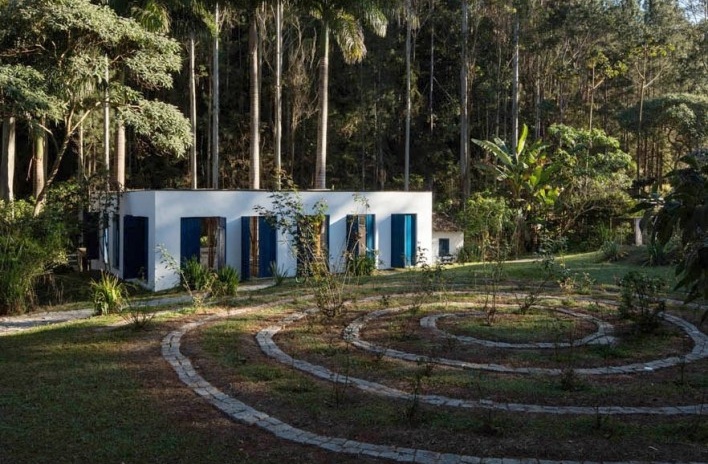
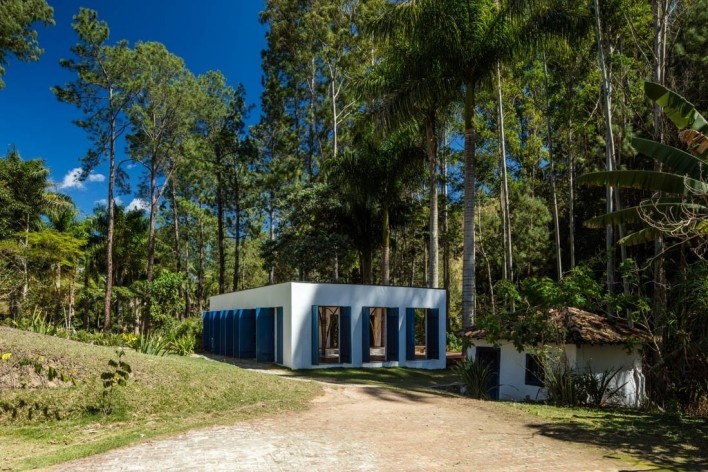
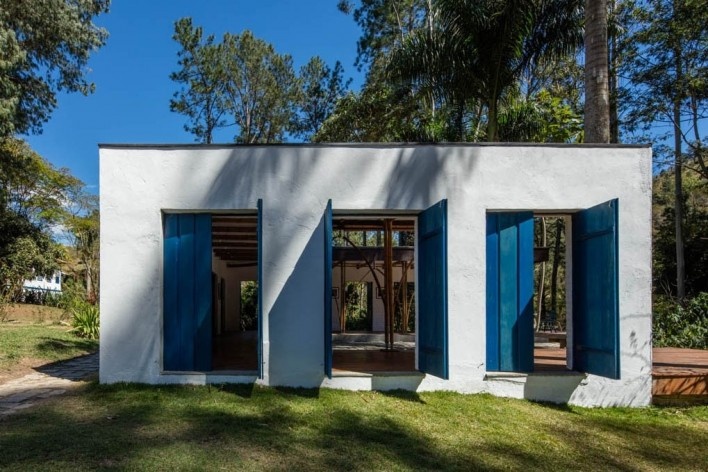
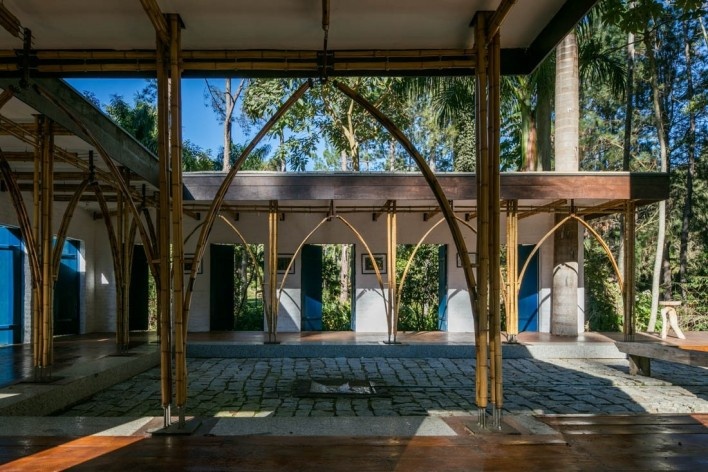
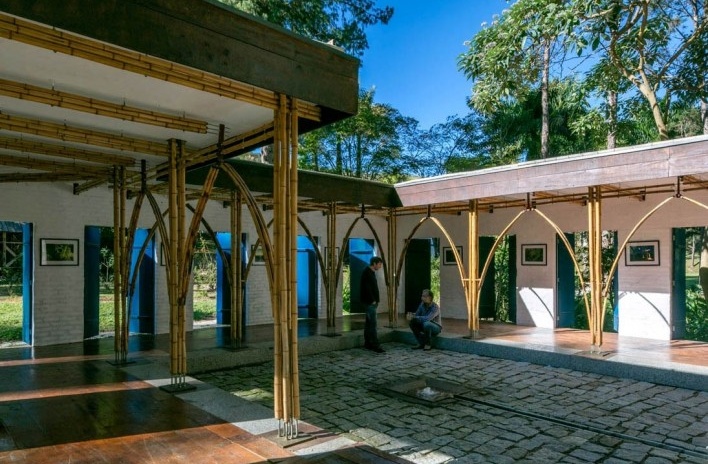
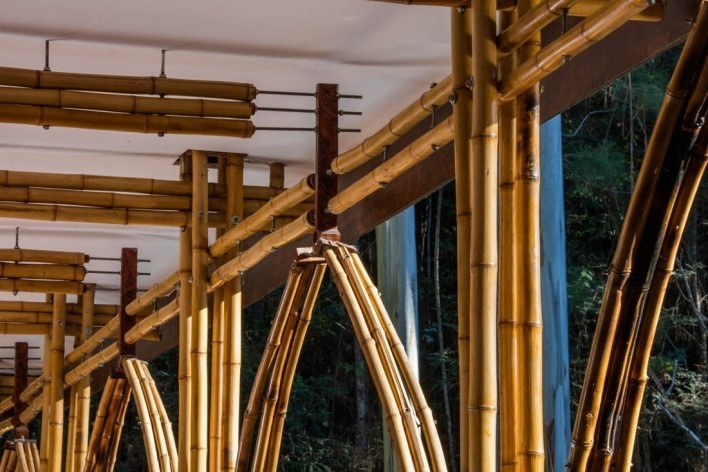
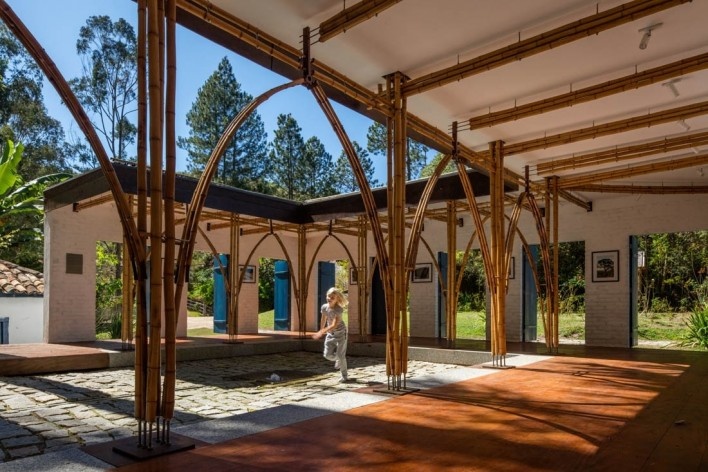
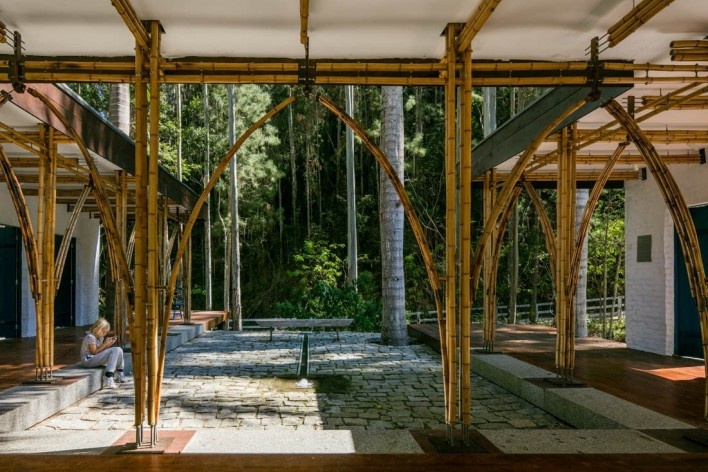
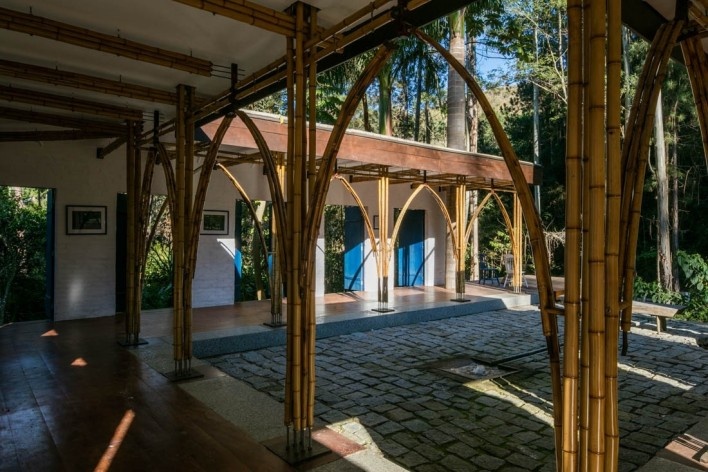
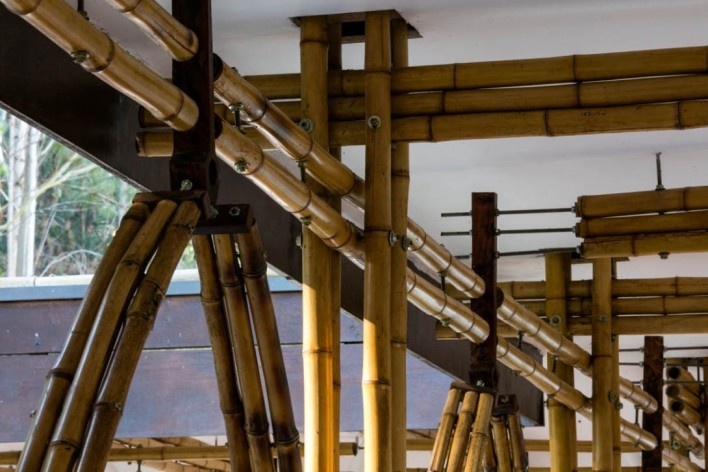
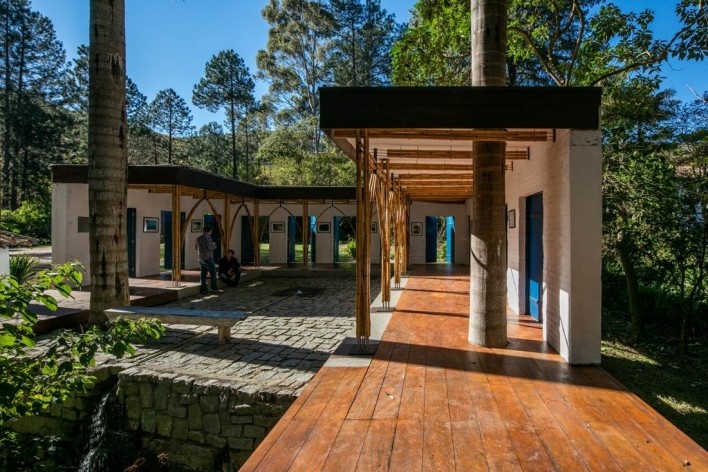
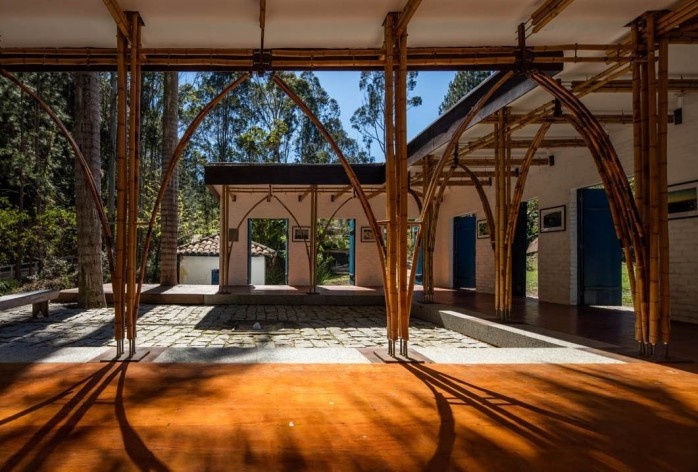
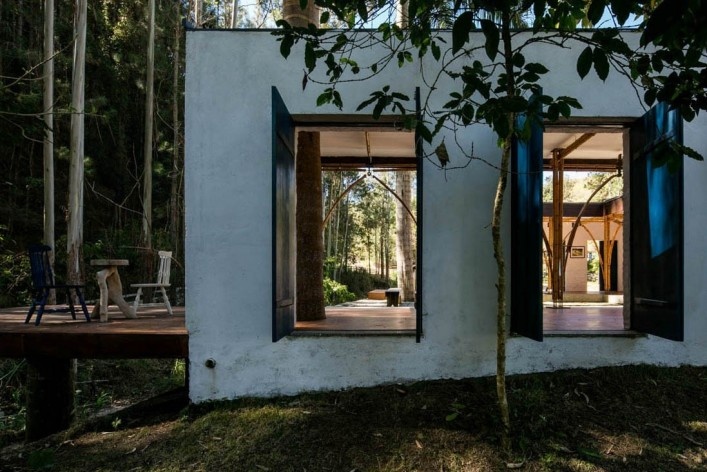
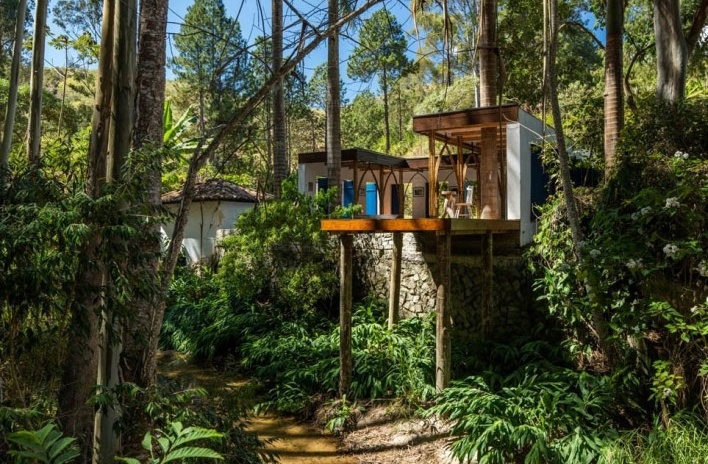
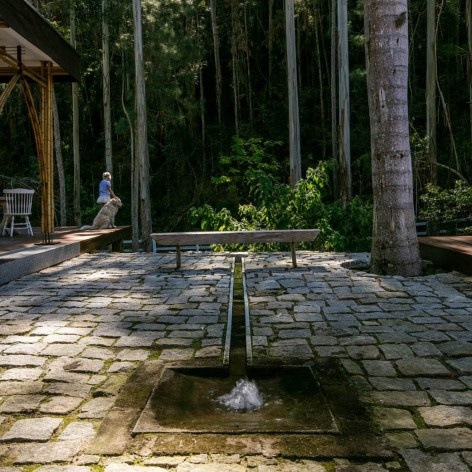
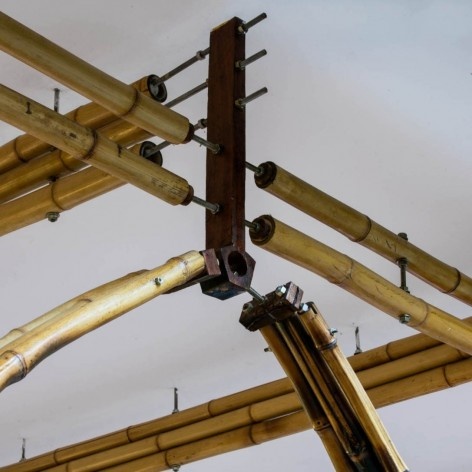
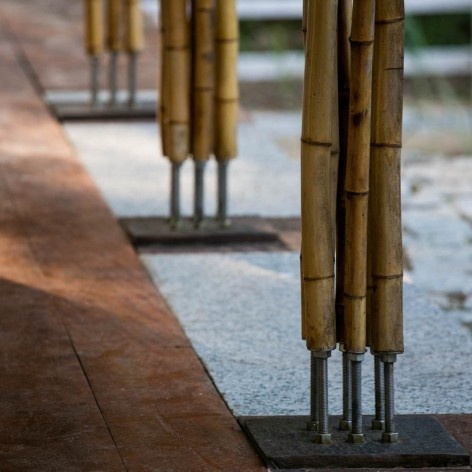
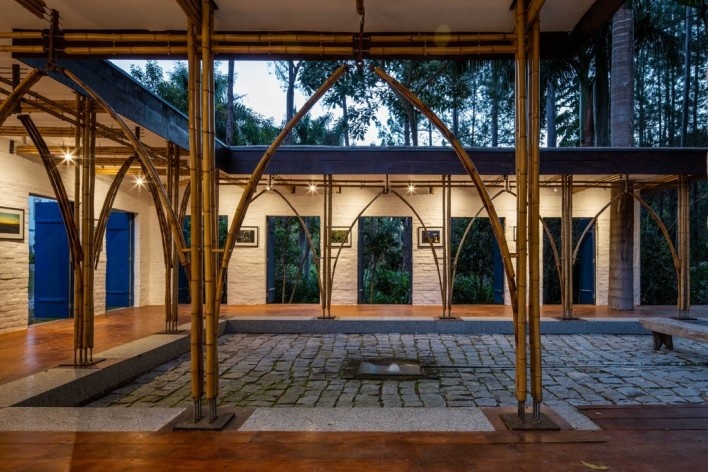
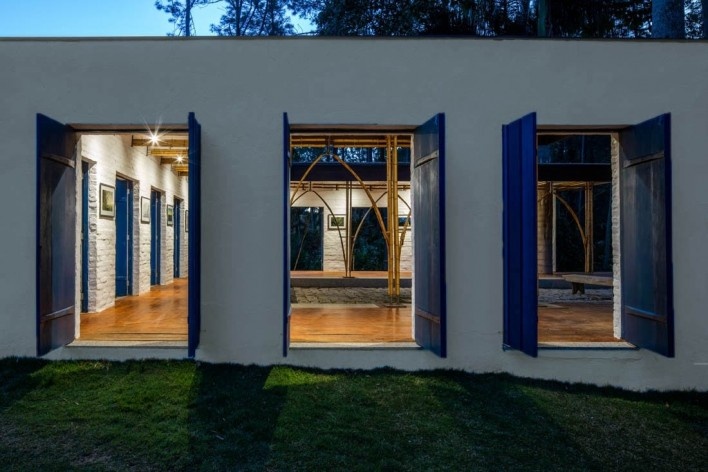
![Art Gallery Catucaba, isometric view, São Luiz do Paraitinga SP Brasil, 2017. Arquiteto Sven Mouton / escritorio CRU! Architects<br />Imagem divulgação [Acervo CRU! Architects/ Sven Mouton]](https://vitruvius.com.br/media/images/magazines/grid_12/443dc85ac28b_hotel_catucaba_cru_sven_mouton_05.jpg)
![Art Gallery Catucaba, front elevation, São Luiz do Paraitinga SP Brasil, 2017. Arquiteto Sven Mouton / escritorio CRU! Architects<br />Imagem divulgação [Acervo CRU! Architects/ Sven Mouton]](https://vitruvius.com.br/media/images/magazines/grid_12/b14728d9914c_hotel_catucaba_cru_sven_mouton_02.jpg)
![Art Gallery Catucaba, left elevation, São Luiz do Paraitinga SP Brasil, 2017. Arquiteto Sven Mouton / escritorio CRU! Architects<br />Imagem divulgação [Acervo CRU! Architects/ Sven Mouton]](https://vitruvius.com.br/media/images/magazines/grid_12/cc4ca6e22adf_hotel_catucaba_cru_sven_mouton_03.jpg)
![Art Gallery Catucaba, plan, São Luiz do Paraitinga SP Brasil, 2017. Arquiteto Sven Mouton / escritorio CRU! Architects<br />Imagem divulgação [Acervo CRU! Architects/ Sven Mouton]](https://vitruvius.com.br/media/images/magazines/grid_12/f15db5aa03a1_hotel_catucaba_cru_sven_mouton_01.jpg)
![Art Gallery Catucaba, isometric view, São Luiz do Paraitinga SP Brasil, 2017. Arquiteto Sven Mouton / escritorio CRU! Architects<br />Imagem divulgação [Acervo CRU! Architects/ Sven Mouton]](https://vitruvius.com.br/media/images/magazines/grid_12/80893ba4def0_hotel_catucaba_cru_sven_mouton_07.jpg)
![Art Gallery Catucaba, isometric view, São Luiz do Paraitinga SP Brasil, 2017. Arquiteto Sven Mouton / escritorio CRU! Architects<br />Imagem divulgação [Acervo CRU! Architects/ Sven Mouton]](https://vitruvius.com.br/media/images/magazines/grid_12/2671245fe106_hotel_catucaba_cru_sven_mouton_04.jpg)
![Art Gallery Catucaba, isometric view, São Luiz do Paraitinga SP Brasil, 2017. Arquiteto Sven Mouton / escritorio CRU! Architects<br />Imagem divulgação [Acervo CRU! Architects/ Sven Mouton]](https://vitruvius.com.br/media/images/magazines/grid_12/de56827b4901_hotel_catucaba_cru_sven_mouton_06.jpg)
![Art Gallery Catucaba, detail, São Luiz do Paraitinga SP Brasil, 2017. Arquiteto Sven Mouton / escritorio CRU! Architects<br />Imagem divulgação [Acervo CRU! Architects/ Sven Mouton]](https://vitruvius.com.br/media/images/magazines/grid_12/6ee3a8f12441_hotel_catucaba_cru_sven_mouton_08.jpg)



















![Art Gallery Catucaba, isometric view, São Luiz do Paraitinga SP Brasil, 2017. Arquiteto Sven Mouton / escritorio CRU! Architects<br />Imagem divulgação [Acervo CRU! Architects/ Sven Mouton]](https://vitruvius.com.br/media/images/magazines/gallery_thumb/443dc85ac28b_hotel_catucaba_cru_sven_mouton_05.jpg)
![Art Gallery Catucaba, front elevation, São Luiz do Paraitinga SP Brasil, 2017. Arquiteto Sven Mouton / escritorio CRU! Architects<br />Imagem divulgação [Acervo CRU! Architects/ Sven Mouton]](https://vitruvius.com.br/media/images/magazines/gallery_thumb/b14728d9914c_hotel_catucaba_cru_sven_mouton_02.jpg)
![Art Gallery Catucaba, left elevation, São Luiz do Paraitinga SP Brasil, 2017. Arquiteto Sven Mouton / escritorio CRU! Architects<br />Imagem divulgação [Acervo CRU! Architects/ Sven Mouton]](https://vitruvius.com.br/media/images/magazines/gallery_thumb/cc4ca6e22adf_hotel_catucaba_cru_sven_mouton_03.jpg)
![Art Gallery Catucaba, plan, São Luiz do Paraitinga SP Brasil, 2017. Arquiteto Sven Mouton / escritorio CRU! Architects<br />Imagem divulgação [Acervo CRU! Architects/ Sven Mouton]](https://vitruvius.com.br/media/images/magazines/gallery_thumb/f15db5aa03a1_hotel_catucaba_cru_sven_mouton_01.jpg)
![Art Gallery Catucaba, isometric view, São Luiz do Paraitinga SP Brasil, 2017. Arquiteto Sven Mouton / escritorio CRU! Architects<br />Imagem divulgação [Acervo CRU! Architects/ Sven Mouton]](https://vitruvius.com.br/media/images/magazines/gallery_thumb/80893ba4def0_hotel_catucaba_cru_sven_mouton_07.jpg)
![Art Gallery Catucaba, isometric view, São Luiz do Paraitinga SP Brasil, 2017. Arquiteto Sven Mouton / escritorio CRU! Architects<br />Imagem divulgação [Acervo CRU! Architects/ Sven Mouton]](https://vitruvius.com.br/media/images/magazines/gallery_thumb/2671245fe106_hotel_catucaba_cru_sven_mouton_04.jpg)
![Art Gallery Catucaba, isometric view, São Luiz do Paraitinga SP Brasil, 2017. Arquiteto Sven Mouton / escritorio CRU! Architects<br />Imagem divulgação [Acervo CRU! Architects/ Sven Mouton]](https://vitruvius.com.br/media/images/magazines/gallery_thumb/de56827b4901_hotel_catucaba_cru_sven_mouton_06.jpg)
![Art Gallery Catucaba, detail, São Luiz do Paraitinga SP Brasil, 2017. Arquiteto Sven Mouton / escritorio CRU! Architects<br />Imagem divulgação [Acervo CRU! Architects/ Sven Mouton]](https://vitruvius.com.br/media/images/magazines/gallery_thumb/6ee3a8f12441_hotel_catucaba_cru_sven_mouton_08.jpg)
